Swivel Chair Syndrome: Why It’s Killing Productivity & How to Fix It
Ever feel like your team spends more time switching between systems than actually working? That’s the reality of Swivel Chair Syndrome, and it’s frustrating users across industries.
If your employees are constantly copying and pasting data, logging into multiple platforms, and manually reconciling information, your business is losing both time and money. Swivel Chair Syndrome isn’t just a workflow inefficiency it’s a major drain on productivity, accuracy, and morale.
In this post, we’ll break down:
- What Swivel Chair Syndrome is and why it happens
- The biggest problems it creates for employees and businesses
- How to fix it with smart system integration
By the end, you’ll understand how to eliminate Swivel Chair Syndrome and create a smoother, more efficient workflow for your team.
What Is Swivel Chair Syndrome? 
Swivel Chair Syndrome happens when employees have to manually move data between multiple, disconnected systems. Instead of a seamless, automated workflow, users constantly switch between different platforms, copying and pasting information or re-entering the same data multiple times.
Think of an employee who has to:
- Log into a CRM to check customer details
- Pull a report from an ERP for sales numbers
- Manually update an inventory system to reflect changes
- Email a spreadsheet to another department for reconciliation
Not only is this time-consuming, but it’s also error-prone. Every extra step increases the chance of mistakes, delays, and inconsistencies.
What Causes Swivel Chair Syndrome?
Most companies don’t intentionally create these workflow nightmares. Swivel Chair Syndrome usually happens because of:
- A Patchwork of Legacy Systems: Businesses add tools over time without considering how they’ll work together.
- Lack of Integration: Platforms don’t naturally “talk” to each other, forcing employees to manually transfer data.
- Departmental Silos: Each department picks its own software, making cross-team collaboration difficult.
- Rapid Growth or Acquisitions: Companies merge tech stacks but fail to integrate them properly.
The result? Frustrated employees, wasted resources, and an inefficient business model.
Why Swivel Chair Syndrome Is Killing Productivity
Companies dealing with Swivel Chair Syndrome face more than just minor inefficiencies, it creates serious operational and financial challenges.
- It Wastes Time & Lowers Productivity
- Employees spend hours each week toggling between systems, logging in and out, and manually inputting data. Research shows that context switching can reduce productivity by up to 40%.
Example: A customer service rep takes twice as long to resolve an issue because they have to pull information from five different platforms.
- It Increases Errors & Compliance Risks
- Manual data entry is a recipe for mistakes. Duplicate records, missing information, and incorrect inputs can lead to financial discrepancies, compliance violations, and even legal trouble.
Example: A healthcare provider manually enters patient data into multiple systems, leading to discrepancies in billing and records.
- It Frustrates Employees & Reduces Retention
- Nobody likes busywork. When employees feel their time is wasted on repetitive tasks, morale drops and turnover rises. A poor digital experience can drive top talent away.
Example: A sales rep spends more time on admin work than actually selling, leading to burnout and dissatisfaction.
- It Harms the Customer Experience
- Customers expect fast, seamless service. When employees struggle to find accurate information, it delays responses, increases errors, and frustrates clients.
Example: A customer calls for support, but the rep can’t find their purchase history without logging into multiple systems, leading to a poor customer experience.
How to Fix Swivel Chair Syndrome: The 3-Step Solution
The good news? Swivel Chair Syndrome is fixable—but it requires smart integration and a user-first approach.
Step 1: Assess & Map Out the Workflow
Start by identifying the biggest pain points. Where are employees losing the most time? Which systems require the most manual effort?
Key Actions:
- Conduct internal surveys or interviews to get employee feedback
- Identify redundant tasks that could be automated
- Document the systems employees use daily
Step 2: Integrate & Automate Where It Matters Most
The real fix for Swivel Chair Syndrome is seamless system integration. When platforms communicate automatically, manual data entry disappears.
Key Actions:
- Implement APIs or middleware to connect key systems
- Use workflow automation tools to eliminate repetitive tasks
- Ensure real-time data syncing between platforms
Step 3: Optimize for the End User
Even the best integrations fail if they don’t prioritize user experience. Make sure new systems are intuitive and actually improve daily workflows.
Key Actions:
- Choose platforms that align with how employees work
- Provide training and support to ensure adoption
- Regularly review and optimize workflows to keep them efficient
The Future: A Workplace Without Swivel Chair Syndrome
Imagine an environment where:
- Employees work efficiently, without jumping between disconnected systems
- Data flows automatically, reducing errors and delays
- Customer service is seamless, leading to better retention and satisfaction
At 910 Advisors, we specialize in eliminating Swivel Chair Syndrome through strategic integration and automation. Our team helps businesses streamline their workflows, so employees can focus on meaningful work instead of manual tasks.
Want to cure Swivel Chair Syndrome for good? Let’s talk. Visit: www.910advisors.com/contact-us/ for more information!

